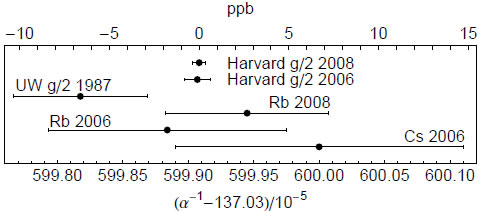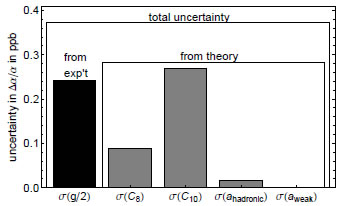| The fine structure constant, α, is a measure of the strength of the electromagnetic coupling constant at low energies. It is one of the most important of our system of fundamental constants. Powers of the fine structure constant times the rest energy of the electron give the size of the various transition energies in atoms. This fundamental constant also determines the Josephson effect and the quantum Hall effect in condensed matter physics. |  |
The 2008 measurement of the electron magnetic moment that we use to determine α here is described here.
The most accurate measurement of the fine structure constant α comes from our 2008 measurement of the electron magnetic moment together with QED calculations (graph below left). The experimental uncertainty is 0.24 ppb while the experimental error is 0.28 ppb, for a combined uncertainty of 0.37 ppb (see graph below right). This determination of the fine structure constant is 12 and 20 times more accurate than are the next most accurate independent determinations (Rb 2008 and Cs 2006). A part per billion is given by ppb = 10-9.
 |
|
 |
 |
Quantum electrodynamics theory (QED) relates the electron magnetic moment in Bohr magnetons (called g/2) to the fine structure constant α. Very impressive QED calculations QED determine the Ck. The small corrections labeled as ax with various subscripts are small corrections that are believed to be well-understood within the standard model of particle physics. In a recent review we tabulate the best values for these constants and the calculations from which they came.
 |
Because we are able to measure g/2 much more accurately than the fine structure constant α can be measured by any independent means, the most accurate value of α comes from inverting this expression to determine this constant in terms of the measured g/2. Notice that our determination of the fine structure constant thus assumes that the standard model of particle physics is correct.
The independent determinations of the fine structure constant that are shown in the figure, along with our more accurate measurement, derive from measurements of the Rydberg constant, an optical frequency, and an atom recoil using atom interferometry. We recently reviewed the most accurate of the measurements of the fine structure constant.
This seems possible. For his thesis work Joshua Dorr will try to develop new methods to measure the electron magnetic moment more accurately, and will do this in a completely new apparatus. Kinoshita (Cornell University) and Nio (Riken, Japan) are hard at work making the challenging QED calculation of the coefficient C10 needed for more accurate determinations of the fine structure constant from the measured electron magnetic moment. The ax corrections are already known well enough to allow a substantial improvement.
© 2015 - Last Updated: 08/30/2018 - Disclaimer